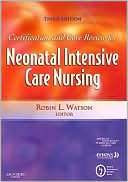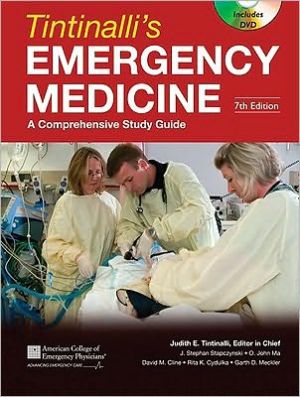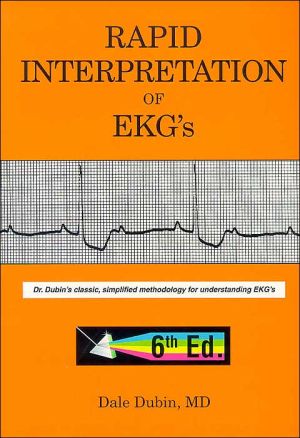Certification and Core Review for Neonatal Intensive Care Nursing
Search in google:
The new edition of this powerful review tool helps readers to assess and build their knowledge of the information covered in AWHONN, AACN, & NANN: Core Curriculum for Neonatal Intensive Care Nursing, 3e. The review book is also authored by AACN (American Association of Critical-Care Nurses), AWHONN (Association of Women's Health, Obstetric, and Neonatal Nurses), and NANN (National Association of Neonatal Nurses) and is a companion to the Core Curriculum. The Core Review includes 600 multiple-choice study questions to challenge readers' mastery of all the essential knowledge in the field. Written under the authority of the American Association for Critical-Care Nurses (AACN) and reviewed by the Association of Women's Health, Obstetric, and Neonatal Nurses (AWHONN) and the National Association of Neonatal Nurses (NANN), it is an ideal study tool to facilitate preparation for neonatal critical-care nursing certification.• Endorsed by the American Association of Critical-Care Nurses; the Association of Women's Health, Obstetric, and Neonatal Nurses; and the National Association of Neonatal Nurses • Based on the Core Curriculum for Neonatal Intensive Care Nursing, 3e • Answers are provided for each question, accompanied by rationales and references, to assist readers in building their knowledge • Questions mirror the certification exam content, multiple-choice question format, and content distribution, giving readers realistic practice for the exam • Content on special needs patients • Heavily illustrated to assist with learning• New content questions for the following new chapters in the Core Curriculum for Neonatal Intensive Care Nursing, 3e:• Fluid and Electrolyte Management • Glucose Management • Lab and Diagnostic Test Management Interpretation • Family Centered Care • Care of the Extremely Low Birth Weight Infant Doody Review Services Reviewer:Amy L Bubbico, DMin, MSN, MA, (Presbyterian Hospital)Description:This neonatal nursing review highlights key study areas through the use of questions related to core concepts in neonatal intensive care nursing. It is intended as a companion to Core Curriculum for Neonatal Intensive Care Nursing, 3rd edition, Verklan and Walden (Elsevier, 2004).Purpose:This book is designed as a study guide and resource for nurses who are preparing to take the national certification exam in neonatal intensive care nursing. This tool allows nurses to review and direct their attention to crucial areas of study as well as identify areas of weakness in their knowledge base. Audience:According to the editor, this book targets a variety of readers. It provides review and critical thinking guidance for newly employed nurses as well as skilled neonatal nurse practitioners or clinical nurse specialists. As a clinical nurse specialist in neonatal intensive care, I think this works as a quick review and as a functional tool for guiding nurse orientation and didactic refinement. The authors are skilled and well prepared from the perspective of neonatal medicine and thus are superior contributors to this work. Features:The book provides study and critical thinking questions related to general assessment and management of the neonate, pathophysiology of neonatal disease entities, care of the premature and extremely premature infant, and, finally, ethical, legal and research issues related to professional practice in newborn intensive care. One of the book's best features is that it not only provides study and review guidance, but immediate feedback in the form of answers and rationale for the questions. Dermatological, audiological, ophthalmic, and immunologic issues are not extensively covered, but neither are they tested extensively on the certification exams. Assessment:It is essential that this review is updated with subsequent editions of the Core Curriculum, since it provides current information and research that will likely be seen on future certification exams and can be used in clinical practice.
Section I: General Assessment and ManagementChapter 1. Assessment of Fetal Well Being (10)Significance of findings-Alpha-fetoprotein-Biophysical profile-Diagnostic ultrasound-Lung maturation studiesRecognize neonatal significance of fetal heart rate patterns-Altered variability-Decelerations-Tachycardia, bradycardiaEffects of maternal medications on fetus/neonate-Tocolytics-Analgesia, anesthesiaImpact of methods of delivery mode on neonateChapter 2. Adaptation to Extrauterine Life (11)Transitional circulationRoutine care considerationsRecognition of the sick newbornChapter 3. Neonatal Resuscitation (10)AHA/AAP guidelines for neonatal resuscitation-Initial evaluation-Indications for ventilation-Indications for intubation-Indications for compressions-Resuscitation of the infant born through meconium stained amniotic fluid-Indication for chest compressions-Use of resuscitation medications: epinephrine, volume expanders, sodium bicarbonateResuscitation of the neonate with-Diaphragmatic hernia-Hydrops fetalis-Perinatal asphyxia-Upper airway obstructionChapter 4. Physical Assessment (42)General appearanceHeadEyes, ears, nose and throatNeckChestAbdomenGenitaliaExtremitiesSpine/backSkinNeuromuscular and reflexesChapter 5. Gestational Age Assessment (32)Interpretation of growth curvesPhysical and neuromuscular characteristics-Preterm-Term-Postterm-SGA-AGA-LGAAssociated risks with-Preterm-Postterm-SGA-LGAChapter 6. Thermoregulation (21)Mechanisms of heat loss and productionMaintaining a neurtralthermal environmentManagement of thermoregulation problemsEquipment-Incubators: servo controlled vs non-servo controlled-Radiant warmersChapter 7. Fluid and Electrolytes (21)Normal fluid and electrolyte requirementsMonitoring fluid and electrolyte statusChapter 8. Nutrition Management (21)Nutritional requirementsEnteral feeding-Minimal enteral feeding-Gavage feeding-Bottle feeding-Breast feedingParenteral nutrition-Indications-Composition-ComplicationsDietary supplements-Breast milk fortifiers-Glucose polymers-Iron-MCT oil-VitaminsChapter 9. Developmental Support (21)Neurobehavioral developmentStability and stress signalsImpact of the NICU environmentIntervention strategies-Reducing noise levels-Reducing light levels/diurnal patterns-Altering care patterns-Handling-Positioning-Kangaroo care-Non-nutritive sucking-Provision of sensory experiencesChapter 10. Radiographic Evaluation (11)Xray views commonly used in newbornsRadiographic densitiesIndwelling lines and tubesRadiographic features of common newborn diseases/defects/conditionsChapter 11. Pharmacology (10)Priniciples of neonatal pharmacology-Administration methods/issues-Absorption from GI tract, skin, muscle-Serum drug levels (toxic vs therapeutic)-Drug distribution in the body-Drug excretion-Drug incompatibilitiesDosage calculationsCommon drugsSafety issuesSection II: PathophysiologyChapter 12. Pulmonary Disorders (99)System wide knowledge (assessment and monitoring)-Anatomy and physiology-Maturational anatomy and physiology-Invasive, non-invasive diagnostic studies-Relevant pharmacology-Implications of system failure on other systems-Respiratory monitoring: pulse oximeter, transcutaneous O2/CO2, end tidal CO2Respiratory infectionsRespiratory distress syndromeTransient tachypnea of the newbornApnea of prematurityPersistent pulmonary hypertension of the newbornAspiration pneumoniaMeconium aspirationPulmonary hemorrhageAir leaksBronchopulmonary dysplasiaDiaphragmatic herniaChoanal atresiaPulmonary hypoplasiaVocal cord paralysisPhrenic nerve palsy/damageSurfactant administrationChest tubes and drainage systemsEndotracheal intubationEntotracheal tube suctioningMechanical ventilation: cpap, conventional ventilation, high frequencyChapter 13. Cardiovascular Disorders (58)System wide knowledge (assessment and monitoring)-Anatomy and physiology-Maturational anatomy and physiology-Invasive, non-invasive diagnostic studies-Relevant pharmacology-Implications of system failure on other systems-EKG monitoring-Hemodynamic monitoringCongenital heart defectCongestive heart failure/pulmonary edemaRhythm disturbances, conduction system defectsShock (hypovolemic, cardiogenic, distributive)HypertensionTamponadeChapter 14. Gastrointestinal Disorders (26)System wide knowledge (assessment and monitoring)-Anatomy and physiology-Maturational anatomy and physiology (includes GER, TPN complications)-Invasive, non-invasive diagnostic studies-Relevant pharmacology-Implications of system failure on other systemsTracheoesophageal fistulaOmphalocele/gastroschisisMalrotation/VolvulusNecrotizing enterocolitisShort bowel syndromeMeconium ileusMeconium plugIntestinal obstructions (duodenal, jejunal, ileal, imperforate anus)Gastroesophageal refluxChapter 15. Metabolic/Endocrine Disorders (17)System wide knowledge (assessment and monitoring)-Anatomy and physiology-Maturational anatomy and physiology-Invasive, non-invasive diagnostic studies-Relevant pharmacology-Implications of system failure on other systemsInborn errors of metabolism / Newborn screeningInfants of diabetic mothersHypoglycemia/hyperglycemiaHypocalcemia/hypercalcemiaRicketsHypothyroidism/hyperthyroidismChapter 16. Hematologic Disorders (17)System wide knowledge (assessment and monitoring)-Anatomy and physiology-Maturational anatomy and physiology-Invasive, non-invasive diagnostic studies-Relevant pharmacology-Implications of system failure on other systemsHyperbilirubinemiaDICIdiopathic thrombocytopenia purpuraRh incompatibilities/ABO incompatibilitiesAnemiaPolycythemia/hyperviscosityHydrops fetalisChapter 17. Neurologic Disorders (22)System wide knowledge (assessment and monitoring)-Anatomy and physiology-Maturational anatomy and physiology-Invasive, non-invasive diagnostic studies-Relevant pharmacology-Implications of system failure on other systems-Signs of increased ICP-Ventricular reservoirs/shuntBirth injuriesHydrocephalusIntracranial hemorrhagePeriventricular leukomalaciaHypoxic ischemic encephalopathyNeural tube defectsSeizuresChapter 18. Renal and Genitourinary Disorders (10)System wide knowledge (assessment and monitoring)-Anatomy and physiology-Maturational anatomy and physiology-Invasive, non-invasive diagnostic studies-Relevant pharmacology-Implications of system failure on other systemsAcute renal failureAmbiguous genitaliaInguinal herniaHydroceleCongenital renal abnormalities (polycystic kidneys, exstrophy of bladder, Potter’s syndrome)Urinary tract infectionChapter 19. Genetics (10)Mendelian inheritance patternsChromosomal anomalies and diseasesMultifactorial diseasesChapter 20. Immunological Disorders and Infections (17)Laboratory values-WBC-CSFImmature host defensesNeonatal sepsis/meningitisViral/fungal infectionsSpecific bacterial infections-Chlamydia-E. coli-Group B streptococcal infection-Staphylococcal infectionInfection control proceduresChapter 21. Dermatologic Disorders (6)Care of newborn’s skinCommon skin lesionsChapter 22. Auditory and Opthalmologic Disorders (5)Hearing screeningEye prophylaxisRetinopathy of prematuritySection III: MultisystemChapter 23. Maternal-Fetal Complications (20)Effects of maternal medical complications-Hematologic (thrombocytopenia, anemia)-Hypertension (PIH, HELLP)-Infections-Renal diseaseProblems associated with amniotic fluid and membranes-Amniotic bands-Oligohydramnios-Polyhydramnios-PROM and chorioamnionitisProblems in labor-Breech and other abnormal presentations-Maternal hemorrhageObstetric emergencies-Abruptio placenta-Cord prolapse-Placenta previaChapter 24. Pain (11)AssessmentManagement strategiesChapter 25. Substance Abuse (7)Fetal alcohol syndromeNeonatal abstinence syndromeCocaineLaboratory testingChapter 26. Care of the Extremely Low Birth Weight Infant (5)Delivery room managementSpecial considerations for ELBW (e.g., skin care, fluid and electrolytes, thermoregulation)Section IV: Professional Caring and Ethical PracticeChapter 27. Research (10)Understanding/using research findings in clinical practiceEvidence based practiceChapter 28. Legal Issues (10)DocumentationInformed consentStandard of careChapter 29. Ethical Issues (10)Bioethical decision making processRole of nurse in ethical decision making situationsChapter 30. Families in Crisis (10)Parent-infant attachment behaviorsParental stress responsesBarriers to parent infant interactionSpecific circumstances-Adolescent parents-Long distance nurturing-Sibling responsesChapter 31. Discharge Planning and Transition to Home Care (10)CPRFeedingAcute life threatening eventsCar seatsImmunizationsDischarge planning and parent teaching for infants with special needsChapter 32. Synergy Model (10)








